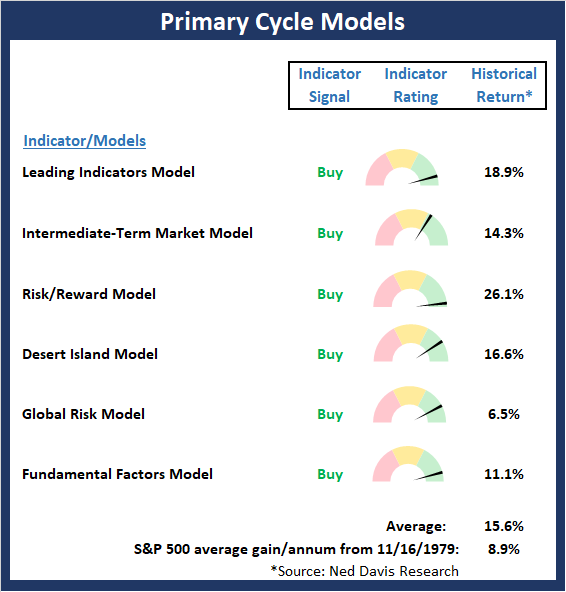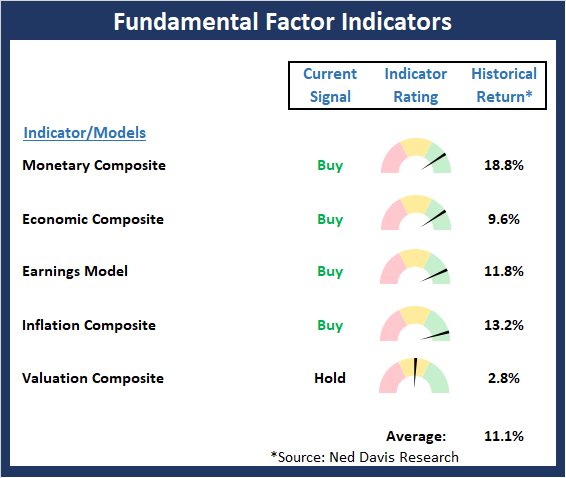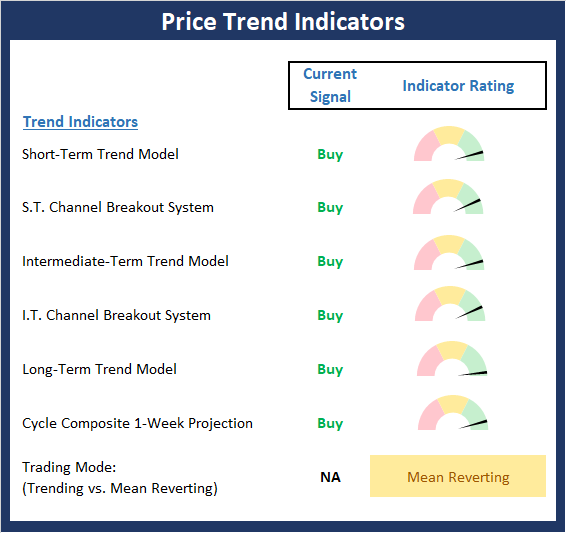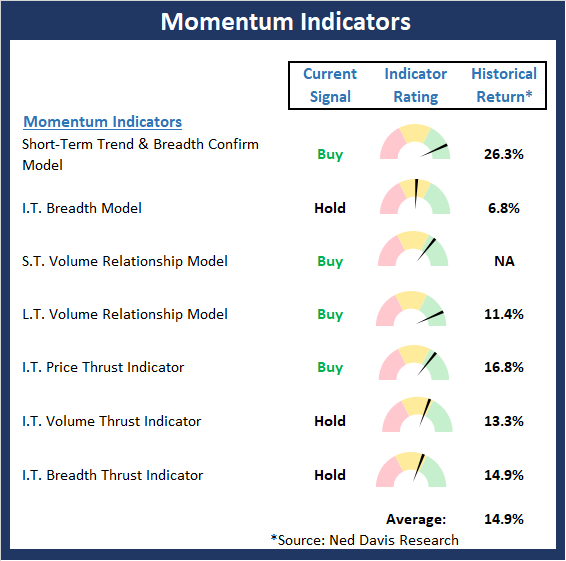How Do We Model For This?
As a risk manager, I try to find and/or create models for as many different market inputs as possible. For example, we have models for corporate earnings, monetary conditions, interest rates, valuations, the U.S. economy, commodities, the global economy, inflation, volatility, overbought/sold conditions, investor sentiment, market momentum, breadth, volume relationships, trends, cycles, leading indicators, lagging indicators, risk/reward, and so on.
The plan here is to try and stay in tune with the "weight of the evidence." To try and remove as much emotion and "gut" instinct as possible. And to basically keep portfolio risk levels in line with overall market conditions.
This isn't always easy. In fact, it is rarely "easy." However, we aren't trying to make big market calls or place huge bets in the portfolios we run. No, our mandate is to try to "get it mostly right, most of the time." And for this approach, using a "weight of the evidence" method (i.e. basing our portfolio's risk levels on the conditions of our market models) using a plethora of market models certainly makes sense - well, to me anyway.
To be sure, the approach we employ has evolved over time and continues to do so every year. I've been at this game for a long time. It is scary to add up the years, but it will suffice to say that I've been responsible for managing the risk of the markets for clients (both advisors and individuals) since 1987. So, yea, it's been a while, and I've seen a LOT over the years.
On that note, what we're seeing in the current market is unusual, to say the least. When trying to "esplain" the market environment to clients, friends, and the occasional acquaintance who is foolish enough to ask my opinion, I find myself suggesting that despite all the modeling, all the research, and all data, we are actually in uncharted waters here - well, to a certain degree at least.
When chatting with my "market geek" friends, I've remarked many times this year that there are no models for some of the current market drivers. Other times, I've suggested that managers are trying to use market models for something that can't be modeled. This gives me pause and/or provides a reason to sit back and question the environment from a big-picture standpoint.
The Tweeter-in-Chief
Exhibit A in my thinking here is the current administration in Washington. The President is an unconventional and almost unpredictable head of state, to say the least. We have learned that he will say almost anything at any time. And his preferred method of communication - Twitter - is also unique/unprecedented. Never before has a President communicated negotiating points in 140 characters or less at all hours of the day/night.
Yes, the markets have adjusted to the President's style of communication and no longer lurch in one direction or another on every tweet storm. However, the markets still move on news/tweets on the important issues such as the current and/or proposed trade wars being waged.
But I ask you, how do we "model" for this? Do we try and take the trend or tenor of the President's tweets on the China trade situation in order to determine the likelihood of a deal getting done? Do we try and place odds on the chances of the administration putting tariffs on French wine or German cars?
Or do we just ignore the whole issue and focus on market fundamentals?
Focus on the Fundamentals Instead?
The problem here is that while I believe market fundamentals such as monetary conditions, earnings, inflation, etc., win out in the long run, inputs on issues such as trade can/do impact the stock indices in the short run.
So, as an investor, if your time frame is somewhere between lunch and next month, then it's probably a good idea to forget about anything except price and momentum models - and the news flow, of course.
However, if you have a longer-term view, then keeping an eye on the fundamental models is a great way to stay on the right side of the market's big-picture trend. This allows you to simply ignore most of the tweets and headlines and remain focused on the primary cycle.
Those Central Bankers
Then there is the Fed. Everybody knows that it doesn't pay to "fight the Fed." This isn't new. However, the idea of global central bankers trying to actively manage the economic cycle through the use of QE certainly is.
I get it. The central bankers of the world don't want to see another crisis. They don't want to see a recession - anywhere - in the near term. And they definitely want to avoid the Japanese-style deflationary spiral. No, they'd prefer to see sustainable growth and a little inflation to make everybody on the planet feel warm and fuzzy about their 401K accounts and the value of their homes.
But come on. The result of the latest round of central bank intervention/management is pretty mind boggling. According to CNBC, the 10-year German bund yielded -0.412% Thursday morning. That's right. If you buy the bund at current prices and hold it to maturity, you are guaranteed to lose money.
The German 30-year traded with a yield of 0.17%. France's 10-year traded with a negative yield. Spanish yields are just above zero. And here's the topper, Greece's benchmark yield traded below 2% Thursday, which, while seemingly impossible, is below the yield of the U.S. 10-Year. Yowza!
We all know why this is happening. Draghi communicated that a rate cut is coming. Powell will cut rates this week. Six other countries have already cut rates. And what this means for traders is that the central bankers are likely to start buying bonds again. So, why not "shake hands with the government" and get in BEFORE the central banks start methodically buying every month?
I saw a report on Friday that $14 trillion of bonds now trade with negative yields. This is up from the reports of $13 trillion a short while back. According to SIFMA (Securities Industry and Financial Markets Association) the total size of the global bond market was $100.13 trillion as of 2017 (Source: Wikipedia). Thus, 14% of the bonds traded in the world now trade at negative rates. Wow.
Again, the game here is to "buy high and sell higher" (oh, and by the way, your buyer is guaranteed to be there once the QE game picks up again). So, buy your bonds now and plan on selling them to the central bankers down the road. Bingo.
I have three questions about all of this. First, does it REALLY make sense for Greek bonds to yield less than the U.S. bonds - I mean, seriously? Second, how does this end (can you say, "bubble")? And finally, how the heck do we model for this unprecedented central bank intervention?
Oh, that's right... silly me... I remember now. Don't fight the Fed. Got it. What could possibly go wrong?
The Bottom Line
Please don't think of me as a Negative Nancy here. Remember, I'm a card-carrying member of the-glass-is-at-least-half-full club - especially when it comes to the market. But the bottom line is history is replete with well-intentioned "managed" economic plans. And since this synchronized global central bank planning thing is new, my thought is that being prepared to manage one's exposure to risk going forward might not be a bad idea.
And yes, we've got a model or two for that.
Weekly Market Model Review
Now let's turn to the weekly review of my favorite indicators and market models...
The State of My Favorite Big-Picture Market Models
There are no changes to the Primary Cycle board this week. In reviewing the component models, the only complaint I have is the less-than stellar reading of our Intermediate-Term Market Model. However, it is important to note that this model incorporates mean reversion indicators, which at this stage of the move are starting to provide warnings. But other than that, the Primary Cycle board suggests investors should remain seated on the bull train.
This week's mean percentage score of my 6 favorite models rose to 84.1% from 79% last week (Prior readings: 83.9%, 81.1%, 73.5%, 62.9%, 65.4%, 62.9%) while the median also improved to to 86.5% versus 80.0% last week (Prior readings: 86.7%, 82.5%, 68.5%, 66.3%, 71.3%, 68.8%, 62.5%).

View My Favorite Market Models Online
The State of the Fundamental Backdrop
Once again, there is no movement in our Fundamental indicators. As I've been saying, the fundamental backdrop for the market remains in good shape.

View Fundamental Indicator Board Online
The State of the Trend
As one would expect with the S&P 500 closing at new highs the end the week, the shorter-term trend indicators perked up last week. The near-term pullback that appeared to be in play at this time last week quickly fizzled out and the anticipated test of the 2950 level simply didn't happen. The only nagging component of the Trend board is the fact that our Trading Mode indicators (there are 5) remain stuck in "mean reverting" mode. This tells us that while price is advancing, all is not right (yet?) in the indicator world.

View Trend Indicator Board Online
The State of Internal Momentum
As I mentioned in the trend section, not everything is rosy in the indicator world. Exhibit A in the argument can be seen on the Momentum board. While the board is positive overall, it is worth noting that three component models remain in the neutral zone and as such are not (yet?) confirming the move. But overall, this is a minor condition that can be overlooked from a big-picture standpoint.

View Momentum Indicator Board Online
The State of the "Trade"
We have been talking recently about the idea of the table having been set for some corrective action. However, with the market moving to new highs instead, the "mean reversion" trade "table" will need to be reset. At this point, the place mats are on the table and the plates are being distributed. However, since the silverware and wine glasses are nowhere to be found, we may be looking at an extended "overbought" period, which can be classified as a "good overbought" condition. Yet, the news could still be an important factor in the game, so stay sharp out there.

View Early Warning Indicator Board Online
Thought For The Day:
Courage is what it takes to stand up and speak; courage is also what it takes to sit down and listen. - Winston Churchill
Wishing you green screens and all the best for a great day,

David D. Moenning
Founder, Chief Investment Officer
Heritage Capital Research
HCR Focuses on a Risk-Managed Approach to Investing
What Risk Management Can and Cannot Do
Disclosures
At the time of publication, Mr. Moenning held long positions in the following securities mentioned: None - Note that positions may change at any time.
Leading Indicators Model: A group of indicators that have historically shown tendencies to lead the market at major turning points.
Intermediate-Term Market Model: A composite model (model of models) focused on trend and momentum indicators which has been designed to provide identify intermediate-term trading opportunities.
Risk/Reward Model: A model-of-models intended to provide an overall view of the state of the risk/reward environment. The model includes tape, monetary, and sentiment indicators as well as 7 big-picture market model readings.
Desert Island Model: If I was stranded on a desert island with access to only one market model to manage money with, this would be the model. The model is a comprehensive model-of-models comprised of trend, momentum, mean reversion, economic, monetary, sentiment, and factor-based indicators/models.
External Factors Model: A model-of-models designed to provide a reading on the "macro state" of the market environment. The model is comprised of indicators/models in the areas of various index yields, industrial production, investors sentiment, and historic volatility.
Short-Term Trend-and-Breadth Signal Explained: History shows the most reliable market moves tend to occur when the breadth indices are in gear with the major market averages. When the breadth measures diverge, investors should take note that a trend reversal may be at hand. This indicator incorporates NDR's All-Cap Dollar Weighted Equity Series and A/D Line. From 1998, when the A/D line is above its 5-day smoothing and the All-Cap Equal Weighted Equity Series is above its 25-day smoothing, the equity index has gained at a rate of +32.5% per year. When one of the indicators is above its smoothing, the equity index has gained at a rate of +13.3% per year. And when both are below, the equity index has lost +23.6% per year.
Channel Breakout System Explained: The short-term and intermediate-term Channel Breakout Systems are modified versions of the Donchian Channel indicator. According to Wikipedia, "The Donchian channel is an indicator used in market trading developed by Richard Donchian. It is formed by taking the highest high and the lowest low of the last n periods. The area between the high and the low is the channel for the period chosen."
Intermediate-Term Trend-and-Breadth Signal Explained: This indicator incorporates NDR's All-Cap Dollar Weighted Equity Series and A/D Line. From 1998, when the A/D line is above its 45-day smoothing and the All-Cap Equal Weighted Equity Series is above its 45-day smoothing, the equity index has gained at a rate of +17.6% per year. When one of the indicators is above its smoothing, the equity index has gained at a rate of +6.5% per year. And when both are below, the equity index has lost -1.3% per year.
Cycle Composite Projections: The cycle composite combines the 1-year Seasonal, 4-year Presidential, and 10-year Decennial cycles. The indicator reading shown uses the cycle projection for the upcoming week.
Trading Mode Indicator: This indicator attempts to identify whether the current trading environment is "trending" or "mean reverting." The indicator takes the composite reading of the Efficiency Ratio, the Average Correlation Coefficient, and Trend Strength models.
Volume Relationship Models: These models review the relationship between "supply" and "demand" volume over the short- and intermediate-term time frames.
Price Thrust Model Explained: This indicator measures the 3-day rate of change of the Value Line Composite relative to the standard deviation of the 30-day average. When the Value Line's 3-day rate of change have moved above 0.5 standard deviation of the 30-day average ROC, a "thrust" occurs and since 2000, the Value Line Composite has gained ground at a rate of +20.6% per year. When the indicator is below 0.5 standard deviation of the 30-day, the Value Line has lost ground at a rate of -10.0% per year. And when neutral, the Value Line has gained at a rate of +5.9% per year.
Volume Thrust Model Explained: This indicator uses NASDAQ volume data to indicate bullish and bearish conditions for the NASDAQ Composite Index. The indicator plots the ratio of the 10-day total of NASDAQ daily advancing volume (i.e., the total volume traded in stocks which rose in price each day) to the 10-day total of daily declining volume (volume traded in stocks which fell each day). This ratio indicates when advancing stocks are attracting the majority of the volume (readings above 1.0) and when declining stocks are seeing the heaviest trading (readings below 1.0). This indicator thus supports the case that a rising market supported by heavier volume in the advancing issues tends to be the most bullish condition, while a declining market with downside volume dominating confirms bearish conditions. When in a positive mode, the NASDAQ Composite has gained at a rate of +38.3% per year, When neutral, the NASDAQ has gained at a rate of +13.3% per year. And when negative, the NASDAQ has lost at a rate of -14.279% per year.
Breadth Thrust Model Explained: This indicator uses the number of NASDAQ-listed stocks advancing and declining to indicate bullish or bearish breadth conditions for the NASDAQ Composite. The indicator plots the ratio of the 10-day total of the number of stocks rising on the NASDAQ each day to the 10-day total of the number of stocks declining each day. Using 10-day totals smooths the random daily fluctuations and gives indications on an intermediate-term basis. As expected, the NASDAQ Composite performs much better when the 10-day A/D ratio is high (strong breadth) and worse when the indicator is in its lower mode (weak breadth). The most bullish conditions for the NASDAQ when the 10-day A/D indicator is not only high, but has recently posted an extreme high reading and thus indicated a thrust of upside momentum. Bearish conditions are confirmed when the indicator is low and has recently signaled a downside breadth thrust. In positive mode, the NASDAQ has gained at a rate of +22.1% per year since 1981. In a neutral mode, the NASDAQ has gained at a rate of +14.5% per year. And when in a negative mode, the NASDAQ has lost at a rate of -6.4% per year.
Short-Term Overbought/sold Indicator: This indicator is the current reading of the 14,1,3 stochastic oscillator. When the oscillator is above 80 and the %K is above the %D, the indicator gives an overbought reading. Conversely, when the oscillator is below 20 and %K is below its %D, the indicator is oversold.
Intermediate-Term Overbought/sold Indicator: This indicator is a 40-day RSI reading. When above 57.5, the indicator is considered overbought and wnen below 45 it is oversold.
Mean Reversion Model: This is a diffusion model consisting of five indicators that can produce buy and sell signals based on overbought/sold conditions.
VIX Indicator: This indicators looks at the current reading of the VIX relative to standard deviation bands. When the indicator reaches an extreme reading in either direction, it is an indication that a market trend could reverse in the near-term.
Short-Term Sentiment Indicator: This is a model-of-models composed of 18 independent sentiment indicators designed to indicate when market sentiment has reached an extreme from a short-term perspective. Historical analysis indicates that the stock market's best gains come after an environment has become extremely negative from a sentiment standpoint. Conversely, when sentiment becomes extremely positive, market returns have been subpar.
Intermediate-Term Sentiment Indicator: This is a model-of-models composed of 7 independent sentiment indicators designed to indicate when market sentiment has reached an extreme from a intermediate-term perspective. Historical analysis indicates that the stock market's best gains come after an environment has become extremely negative from a sentiment standpoint. Conversely, when sentiment becomes extremely positive, market returns have been subpar.
Long-Term Sentiment Indicator: This is a model-of-models composed of 6 independent sentiment indicators designed to indicate when market sentiment has reached an extreme from a long-term perspective. Historical analysis indicates that the stock market's best gains come after an environment has become extremely negative from a sentiment standpoint. Conversely, when sentiment becomes extremely positive, market returns have been subpar.
Absolute Monetary Model Explained: The popular cliche, "Don't fight the Fed" is really a testament to the profound impact that interest rates and Fed policy have on the market. It is a proven fact that monetary conditions are one of the most powerful influences on the direction of stock prices. The Absolute Monetary Model looks at the current level of interest rates relative to historical levels and Fed policy.
Relative Monetary Model Explained: The "relative" monetary model looks at monetary indicators relative to recent levels as well as rates of change and Fed Policy.
Economic Model Explained: During the middle of bull and bear markets, understanding the overall health of the economy and how it impacts the stock market is one of the few truly logical aspects of the stock market. When our Economic model sports a "positive" reading, history (beginning in 1965) shows that stocks enjoy returns in excess of 21% per year. Yet, when the model's reading falls into the "negative" zone, the S&P has lost nearly -25% per year. However, it is vital to understand that there are times when good economic news is actually bad for stocks and vice versa. Thus, the Economic model can help investors stay in tune with where we are in the overall economic cycle.
Inflation Model Explained: They say that "the tape tells all." However, one of the best "big picture" indicators of what the market is expected to do next is inflation. Simply put, since 1962, when the model indicates that inflationary pressures are strong, stocks have lost ground. Yet, when inflationary pressures are low, the S&P 500 has gained ground at a rate in excess of 13%. The bottom line is inflation is one of the primary drivers of stock market returns.
Valuation Model Explained: If you want to get analysts really riled up, you need only to begin a discussion of market valuation. While the question of whether stocks are overvalued or undervalued appears to be a simple one, the subject is actually extremely complex. To simplify the subject dramatically, investors must first determine if they should focus on relative valuation (which include the current level of interest rates) or absolute valuation measures (the more traditional readings of Price/Earnings, Price/Dividend, and Price/Book Value). We believe that it is important to recognize that environments change. And as such, the market's focus and corresponding view of valuations are likely to change as well. Thus, we depend on our Valuation Models to help us keep our eye on the ball.
Disclosures
NOT INVESTMENT ADVICE. The opinions and forecasts expressed herein are those of Mr. David Moenning and Heritage Capital Research and may not actually come to pass. The opinions and viewpoints regarding the future of the markets should not be construed as recommendations. The analysis and information in this report is for informational purposes only. No part of the material presented in this report is intended as an investment recommendation or investment advice. Neither the information nor any opinion expressed constitutes a solicitation to purchase or sell securities or any investment program.
Any investment decisions must in all cases be made by the reader or by his or her investment adviser. Do NOT ever purchase any security without doing sufficient research. There is no guarantee that the investment objectives outlined will actually come to pass. All opinions expressed herein are subject to change without notice. Neither the editor, employees, nor any of their affiliates shall have any liability for any loss sustained by anyone who has relied on the information provided.
Mr. Moenning of Heritage Capital Research is an investment adviser representative of Eastsound Capital Advisors, LLC, a registered investment advisor. The adviser may not transact business in states where it is not appropriately registered, excluded or exempted from registration. Individualized responses to persons that involve either the effecting of transaction in securities, or the rendering of personalized investment advice for compensation, will not be made without registration or exemption.
Mr. Moenning and Heritage Capital Research may at times have positions in the securities referred to and may make purchases or sales of these securities while publications are in circulation. Positions may change at any time.
The analysis provided is based on both technical and fundamental research and is provided "as is" without warranty of any kind, either expressed or implied. Although the information contained is derived from sources which are believed to be reliable, they cannot be guaranteed.
The author neither endorses nor warrants the content of this site, any embedded advertisement, or any linked resource. The author or his managed funds may hold either long or short positions in the referenced securities. Republication rights must be expressly granted by author in writing.
Investments in equities carry an inherent element of risk including the potential for significant loss of principal. Past performance is not an indication of future results.

